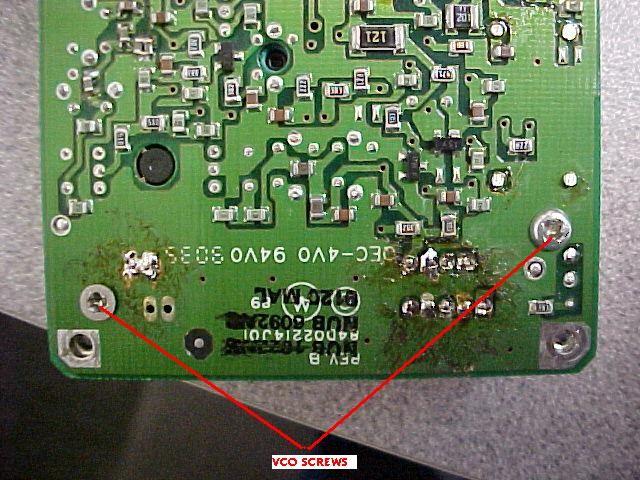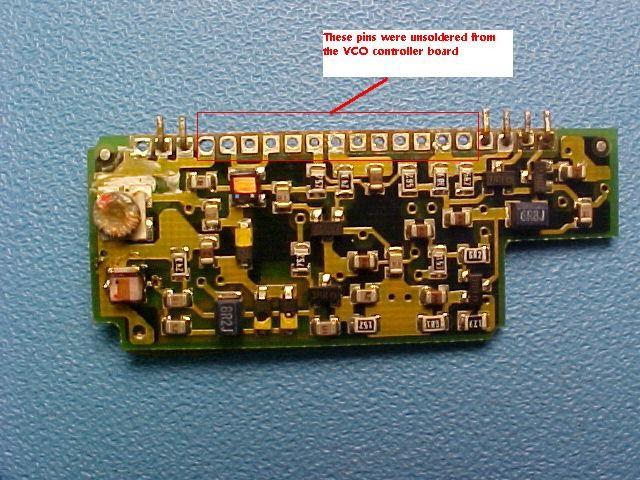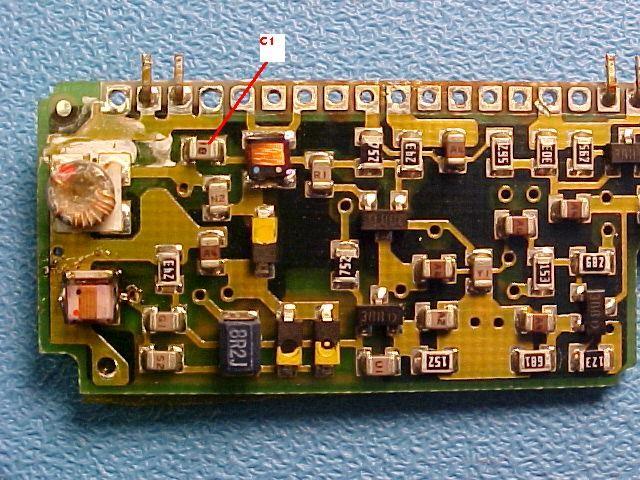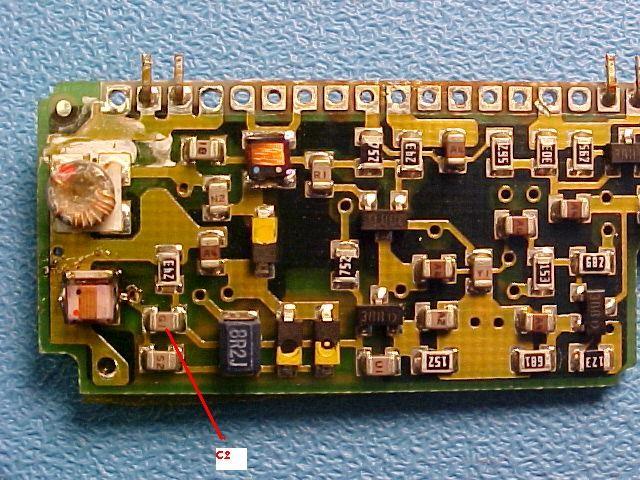Up one level
Back to Home
|
|
Moving the 42 to 50 MHz MT1000 to the 6-meter ham band
By Mike May WB8VLC/7
Photos by the author
|
|

|
I did these mods without a schematic so I have renamed the two capacitors needing
changing using my own nomenclature as C1 and C2.
Parts needed:
I used standard 0805 style chip capacitors such as Panasonic 50 volt NPO chip caps
which are available from Digikey. These are DigiKey / Panasonic parts in the
PCC series. I used these as they are the most temperature stable parts available. See
the note at the end of this document about using the alternate parts for C1 and C2.
DIGIKEY part numbers for components used are as follows:
C1 = Panasonic PCC080CNCT-ND 8pf, alternate = PCC070CNCT-ND 7pf
C2 = Panasonic PCC180CNCT-ND 18pf, alternate = PCC070CNCT-ND 15pf
Data taken after several conversions shows that C1 =7.5 pf and C2 16 pf is perfect to
cover the entire band.
Before performing any of the steps below, first, using Motorola RSS P200LB.EXE, read
the original radio and save the original codeplug. Confirm that it is a 42 to 50
MHz split radio.
You must use RSS, P200LB.EXE and not standard MT1000 RSS for the low band radios. If
the radio you have is not in the 42 to 50 MHz split, then stop right now as the mods to take
a 36 to 42 MHz split to either 6 meters or 10 meters are more complex and still being
documented or worked on at this time. However; I have successfully moved a 36 to 42
MHz split MT1000 to the 10 meter ham band with great results but this is still being
documented as there are numerous receiver pre-selector changes.
Taking the radio apart:
- Open the MT1000 up by removing the two back cover screws and four bottom screws.
Two of the bottom screws hold the battery plate, these are the longer BLACK screws.
The other two screws are smaller and silver colored and they hold the front cover on.
Don't remove the screws holding the battery contacts.
- Pull the front cover away from the back section and disconnect the speaker flex
cable.
- Pull the radio away from and out of the Lexan case by grasping the antenna and
pulling away from the Lexan case.
- Remove the controller module (this is the large metal module in the center of the
radio) away from the main RF board by removing the four side screws and gently
pulling the two top connectors off while gently pushing on the two bottom connectors
(the connectors which attach to the VCO) at the same time to free the controller
board from the main board. Don't pull the controller out very far at this time as
there is a flex connector on the back.
- Carefully pull the controller up and slightly away from the main RF board. Next
carefully remove the back flex cable from the controller module. Place the
controller module aside.
- Turn the radio over so the back metal shield/cover is facing up and remove the four
screws securing the shield to the module.
- Look towards the bottom with the back shield removed and locate two screws
securing the VCO module; they are the only two screws near the bottom of the radio
module. Remove these screws. See Photo 1.

Photo 1, VCO hold down screws
Desoldering the VCO module from the main RF board:
- Using a solder sucker or some de-soldering wick, remove the solder from the 11
pins shown in Photo 2 and pull the VCO module away from the Main Printed circuit
board.

Photo 2, unsoldering VCO from main board
- Once the VCO is removed from the main RF board, pull the snap-on piece of the
three-piece VCO cover off and then pull the top metal cover off of the VCO module
(sorry I don't have picture of this step and my radio is back together so I can't
supply a picture, but the metal covers of the VCO are obvious so this should not be
a problem).
- Referring to Photo 3, desolder the pins from the controller part of the VCO module
so that the RF section of the VCO module can be separated. Pull the RF section of
the VCO board up and away from the remaining metal cover. The result should be
the RF VCO section in Photo 3. Your inductors on the left side of the VCO may
look different from those in my picture but this is not important here.

Photo 3, VCO RF board removed from VCO controller board
- Refer to Photo 4. Remove the capacitor at the location labeled C1 and replace it
with a 0805 case style 8pf chip capacitor. See the note in Radio
Programming step 7 below for alternate cap values.

Photo 4. C1 location. Remove and replace with an 8pf NPO chip capacitor
- Refer to Photo 5. Remove the capacitor at the location labeled C2 and replace it
with a 0805 case style 18pf chip capacitor. See the note in Radio
Programming step 7 below for alternate cap values.

Photo 5. C2 location. replace with an 18pf NPO chip capacitor
- Re-assemble the VCO in reverse order and solder it back in to
the main RF board. Put the VCO module hold down screws back in.
- Re-assemble the controller module to the main RF board being sure to place the
back flex cable on first, then slide the two bottom VCO connectors on and drop the
controller into the Main RF board while carefully attaching the two top connectors to
the controller module.
- * * * * * ADDITION * * * * * 10-March-2008 * * * * *
Some people have reported problems making the radio lock after the conversion and with
the display radios they have reported an error 88.
As a result you will need to ground the PLL lock detect line prior to programming.
Lock detect is the right most pin on the left most 7 pin connector going to the VCO module.
This is the connector closest to the speaker mic flex cable.
Simply connect up a 1 inch piece of jumper wire from pin 7 of this connector and solder
the other end to the shield covering the RF/controller board.
- Re-assemble the covers and the case to put the radio back together.
Radio Programming:
- Start the RSS, open up a copy of the saved codeplug and change all
frequencies to 49.XXX MHz where XXX is the actual frequency information
to the right of the decimal point of your desired frequencies. For example
if channel 1 is 52.525 MHz enter this as 49.525. If channel 2 for
example is 52.56 receive and 52.06 transmit enter as 49.560 receive and
49.060 transmit.
- Enter in all CTCSS tone information and all other desired information
into the codeplug and save the codeplug to disk under a new name (i.e. do
not wipe out your original commercial band code plug archive). Exit the RSS.
- Start up your favorite hexadecimal file editor program and use it to open
the codeplug file. Look for your frequencies. They are very visible as decimal
values and not in hexadecimal format. They are in order of receive frequency
first then the transmit frequency. They should be obvious as viewed in the
hex editor. For the examples above you should see something like:
0101...49525...49525...0202...49560...49060 etc. It's actually pretty easy
to find your way around a hexadecimal editor so I won't get into it anymore
than this.
- Change the 49 MHz part to your desired MHz such as 52 etc., do this
for all the programmed channels and save the codeplug, then exit the hex
editor.
- Go back to P200LB.EXE and look at each channel to ensure the TX and RX
frequencies are correct. Use the channel up/down commands F4 and F3 but do
not move the cursor to the frequency entry field otherwise the RSS will try
and bring them back into the correct split. If there are any errors then fix
them now. You will need to reset the frequencies back to 49.XXX if there are
any errors in tones and other items and start over.
- If all the values in the codeplug are OK, then program the radio and check
each transmit and receive frequency on a service monitor (or equivalent test
equipment) to confirm all frequencies are working properly.
- I only needed transmit up to 53 MHz and receive up to 53.3 so this was the
extent of my testing. If you need to go higher in frequency with your TX or you
find your radio unlocking at the high end of the band on receive, then the
alternate values of capacitors C1 and C2 should be used.
Troubleshooting::
If you have any problems making the radio lock after the conversion you will need to
ground the lock detect line.
This step is Especially important if you converted the using an earlier document which
left out grounding the lock detect line before reprogramming.
The failure will be either the radio not locking on any frequency or with a display radio
and error 88 being displayed.
Lock detect is the right most pin on the left most 7 pin connector going to the VCO module.
This is the connector closest to the speaker mic flex cable.
Simply connect up an ~1 inch piece of jumper wire from pin 7 of this connector and
solder the other end to the shield covering the RF/controller board.
If you tried to program a radio with a modified codeplug with error 88 displayed on
a display radio you may have screwed up the radios internal tuning values.
To fix this simply create a codeplug for the correct model/version of radio that you
have and enter in all frequencies of 49.99 MHz for tx and rx and program this codeplug in the radio.
Next confirm that the radio is working on these channels and if so read this codeplug
out and save it to disk and then use this codeplug that you just read out to hexedit in
your 6 meter channels and it should fix any corrupted internal tuning values.
Back to the top of the page
Up one level
Back to Home
This page originally posted on Thursday 26-Oct-2006
Photographs and article text © Copyright 2006 by Mike May WB8VLC/7.
Hand-coded HTML © Copyright 2006 by Robert Meister WA1MIK.
Date of last update © Copyright 2006 by Repeater-Builder.Com
This web page, this web site, the information presented in and on its pages and
in these modifications and conversions is © Copyrighted 1995 and (date of
last update) by Kevin Custer W3KKC and multiple originating authors. All Rights
Reserved, including that of paper and web publication elsewhere.






